BIOMECHANICS
1/57
There's no tags or description
Looks like no tags are added yet.
Name | Mastery | Learn | Test | Matching | Spaced |
|---|
No study sessions yet.
58 Terms
Biomechanics
Study of motion and the effects of forces relative to the body → applies the laws of mechanics and physics to human performance.
technique efficiency
Injury prevention
Modification of sports equipment
Technology development
Momentum
Measure of the amount of motion possessed by a moving body. Product of mass and velocity (P=mv)
object only has momentum if it is moving
Greater its momentum, more force defend to be applied to stop/slow down
When two objects collide, one with most momentum will be least affected
Impulse
Application of force over a period of time to change the momentum of an object (I=Ft) → F = ma
impulse creates momentum → increases momentum from zero
Changing momentum → increase/decrease momentum of moving object
Stopping momentum → decreasing momentum to zero
Increasing momentum
Increase both force and time component
force is increased through effective summation of force and improved strength
Time is increased through technique and equipment modifications
Decreasing momentum
Increase time component → small peak force over long period.
COEFFICIENT OF RESTITUTION
Coefficient of Restitution (COR)
Measures the elasticity of the collision between an object and a given surface.
How much energy remains in the object after collision occurs
Elasticity → measure of how much rebound exists following a collision.
COR measured on scale of 0 → 1
1 → perfectly elastic collision (rebound back to release height)
0 → perfectly inelastic collision (rebound < release)
Equipment and surfaces
Condition of balls - new tennis ball = high COG vs old balls = low COG
Type of equipment used - American baseball wooden bats are compulsory → aluminium bats have high COG
Type and condition of playing surface - clay court = high COG vs grass = low COG
Temperature of the balls
Increase temp = increased COG
Velocity of collision
Velocity between oncoming ball and swinging implement will alter COG
increase velocity = increase likelihood of ball losing energy due to greater compression of the ball
increased velocity = decreased COG
ANGULAR KINETICS
Angular momentum
Angular momentum = moment of inertia x angular velocity
The quantity of angular motion possessed by a rotating body.
Angular velocity
Refers to the velocity or speed of a rotating object
small angular velocity = large moment of inertia
Large angular velocity = small moment of inertia
Moment of inertia
Refers to the resistance of a rotating object to change its state of motion (mass)
if the mass of angular object is distributed close to the axis of rotation, the moment of inertia is small and it is easier to rotate the object. (Tucked)
As mass of an object moves further away from the axis of rotation, the moment of inertia increases, and rotation becomes harder. (Pike)
When the mass of the object is distributed evenly further away from the axis of rotation, the moment of inertia increases even further and rotation becomes harder again. (Dive)
Eq → moment of inertia = mass of object x radius of rotation
Radius of rotation → how the object’s mass is distributed about the axis of rotation.
by moving the objects mass further away from axis of rotation, you are increasing its radius of rotation and therefore increasing its momentum of inertia, making the object harder to control and generate angular velocity.
Conservation of angular momentum
Indicates a rotating body will continue to rotate indefinitely unless an external force acts on it.
in activities where angular momentum is conserved, sufficient angular momentum must be produced prior to leaving the ground.
Increase linear momentum (run up speed) → transferred into angular momentum
Apply greater force to ground/wall at take-off
Improve segmental interaction at take-off
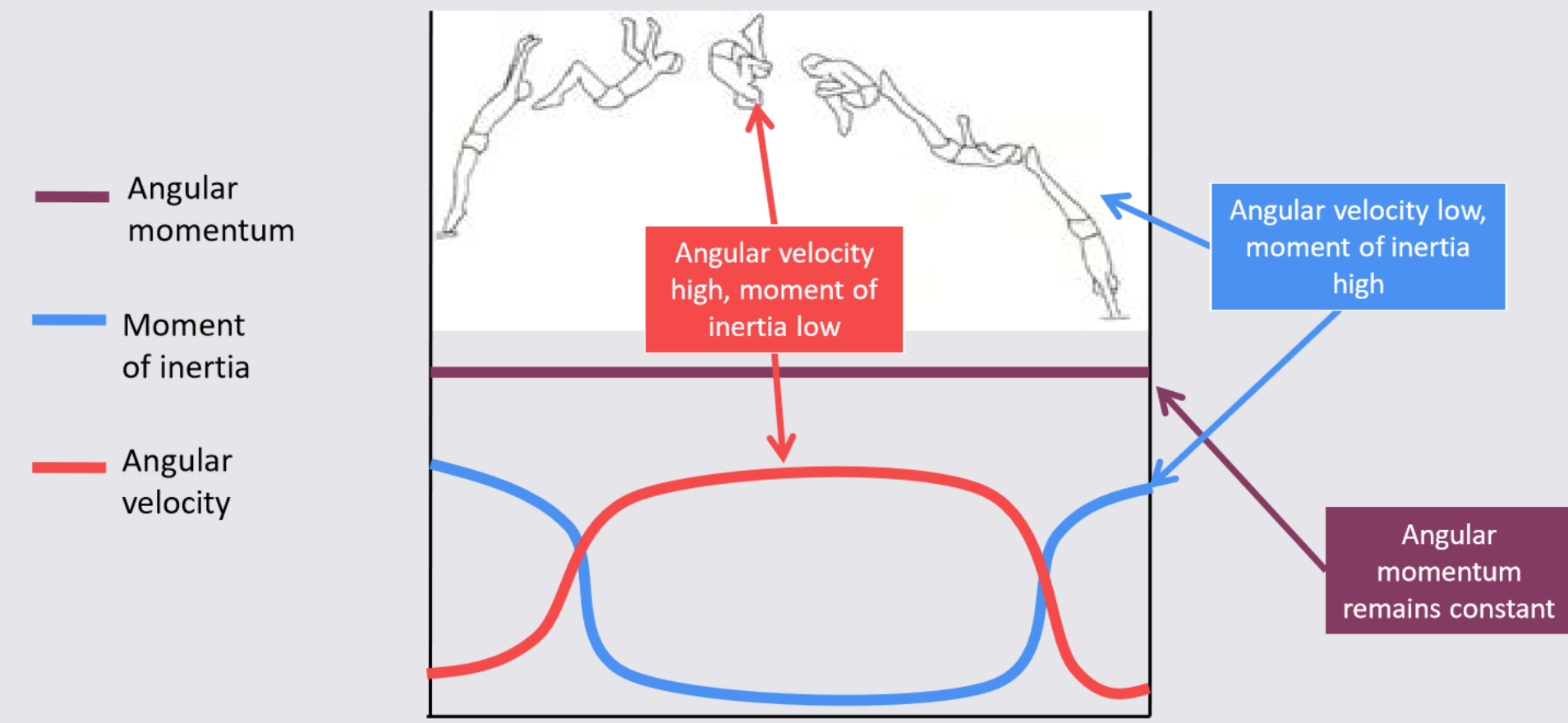
LEVERS
3 main parts of a lever
Resistance - weight or load to be moved
Axis - point the lever rotates
Force - application of force / effort
Key terminology
• Fulcrum/axis - the point around which the lever rotates
• Effort/force arm - the distance between the fulcrum and the point at which the force is applied
• Resistance arm - the distance between the fulcrum and the centre of the resistance
• Input (Effort) Force - Force exerted on the lever
• Output (Resistance) Force - Force exerted by the lever

3rd class lever
The axis is located at one end, with the application of the force in the middle and resistance applied at the opposite end.
FUNCTION
→ speed multiplier - the end of a lever travels a greater displacement over the same period. achieved. As a result, the velocity at the distal end of a lever is greatest, ensuring a speed multiplier is achieved
increasing length of lever = generate greater velocity/angular momentum transferred onto the ball BUT increased length = increased weight = negative affect
All types of levers
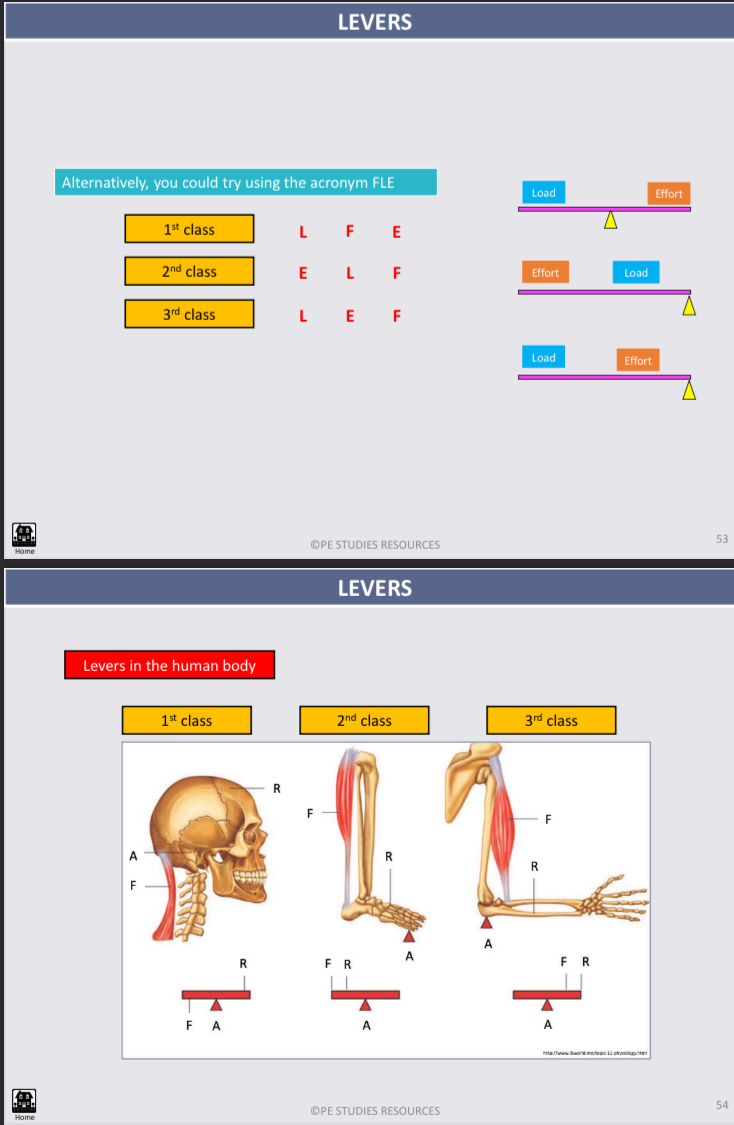
BALANCE
Balance
The ability to neutralise forces that disturb equilibrium OR the ability of something to maintain or hold its position.
size of bass of support - greater bass of support = more balanced
Height of centre of gravity above bass of support - lower COG = more balanced
Position of the line of gravity relative to bass of support - closer LOG is to middle of BOS = more balanced
Mass of object - greater mass = more balanced
SUMMATION OF FORCES
Segmental interaction
Forces acting between the segments of a body can transfer energy between segments OR how body segments interact to meet the task’s demands.
POWER - more segments used. Forces usually sequentially summated (e.g. golf drive)
ACCURACY - less segments needed and usually summated simultaneously (e.g. netball goal shot)
Simultaneous force summation
all body parts move at the same time to produce a force
Generally used to produce accuracy however, some activities do require this method to attain maximum power
E.g. a putt in golf (accuracy) vs a snatch in weightlifting (power)
Sequential force summation
sequential combination of forces produced by different parts of the body, acting together to maximise force.
Generally used to produce max force in whole-body actions such as throwing, kicking and striking
E.g. basketball pitcher, striking in golf, kicking in rugby
How to sequentially produce maximal force
Stronger and larger muscles of thighs and trunk move first, followed by smaller and faster muscles
Sequentially accelerate each body part so optimum momentum passes from one body part to the next
Each body part should be stable so that the next body part accelerates around a stable base to transfer momentum
Use as many body parts as possible to apply force over the maximum possible time
Follow-through is important to prevent deceleration of the last segment and ensure safe force dissipation
Ensure all forces are directed towards the target.
Summation of forces diagram

PROJECTILES
Optimal projection
The relationship between the angle, velocity and the height of release/landing height to attain the athlete’s goal.
if the task demands to maximise distance:
Max velocity → through biomechanical principles
Max height of release → without sacrificing velocity of release/stability
Angle of release → with all other factors equal (wind conditions), throw.strike at angle of ~ 45˚ to max distance due to height of release > landing height
FLUID MECHANICS
Fluid mechanics
The natural science of fluids (liquids and gases) in motion
major fluid forces of interest:
Drag (impacts horizontally)
Lift (impacts vertically)
Boundary layer
Thin layer of air surrounding or ‘attached’ to the ball
laminar (smooth flow, large turbulent pocket at the back of the ball)
Turbulent (rough flow, small turbulent pocket at the back of the ball)
Boundary layer separation → where the boundary layer breaks away from the ball. Earlier the boundary layer separation, the greater the pressure gradient between the front and back of the ball = increased drag.
Turbulent flow and laminar flow
Turbulent flow → flow in which the velocity at any point varies erratically
Laminar flow → type of fluid flow in which fluid moves smoothly in individual layers or streams.
Fluid flows often change from laminar to turbulent when they go over an abrupt feature (such as wind going over a mounted ridge line)
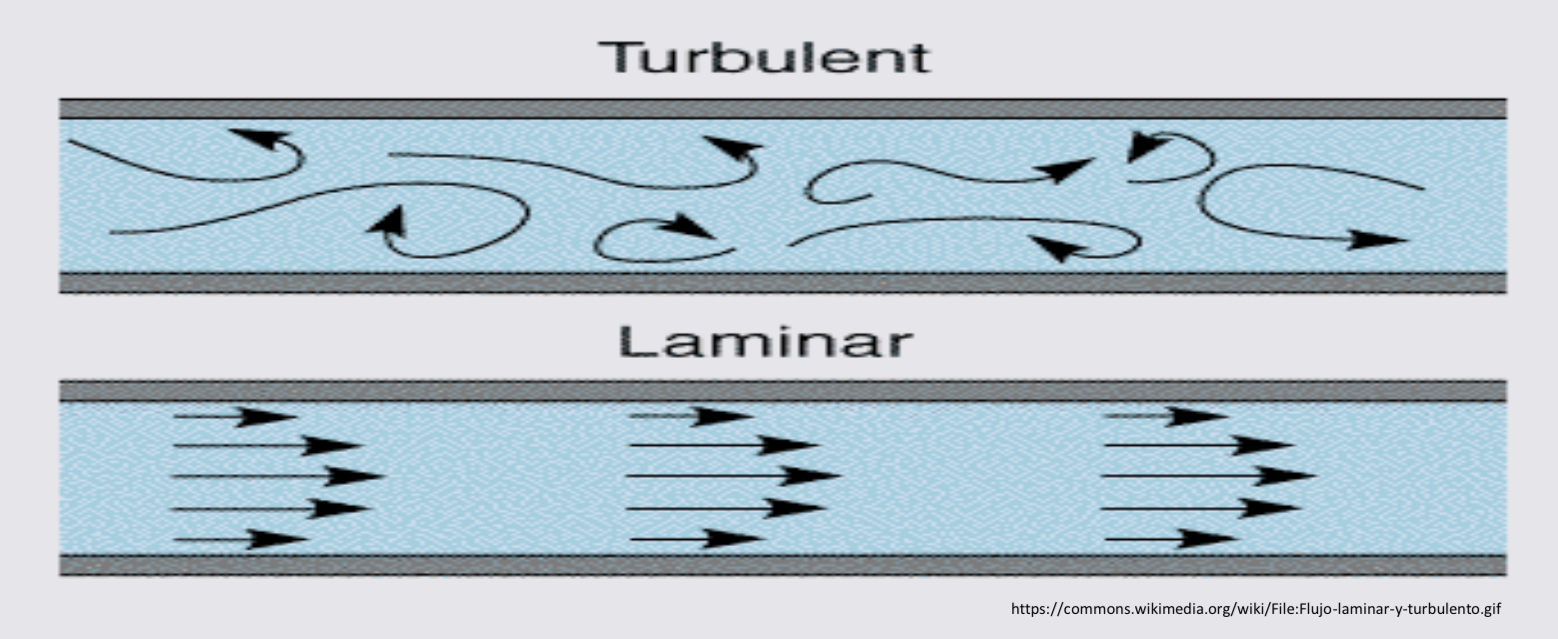
Factors affecting boundary layer separation point
Velocity
low velocity - boundary layer clings to surface, separation well towards the rear
Minor drag
High velocity - separation occurs further forward
Increased drag
Surface roughness
rough surfaces create turbulent boundary layer, reducing the effect of drag
Dimpled golf ball vs smooth golf ball
Swimsuit designs are now rough surfaces, designed to create turbulent boundary layer, resulting in late separation and reduces the effect of drag on the athlete.
Shape
oval ball → boundary layer clings to surface, separation well towards the rear
Minor drag
Round ball → separation occurs further forward
Increased drag
Surface
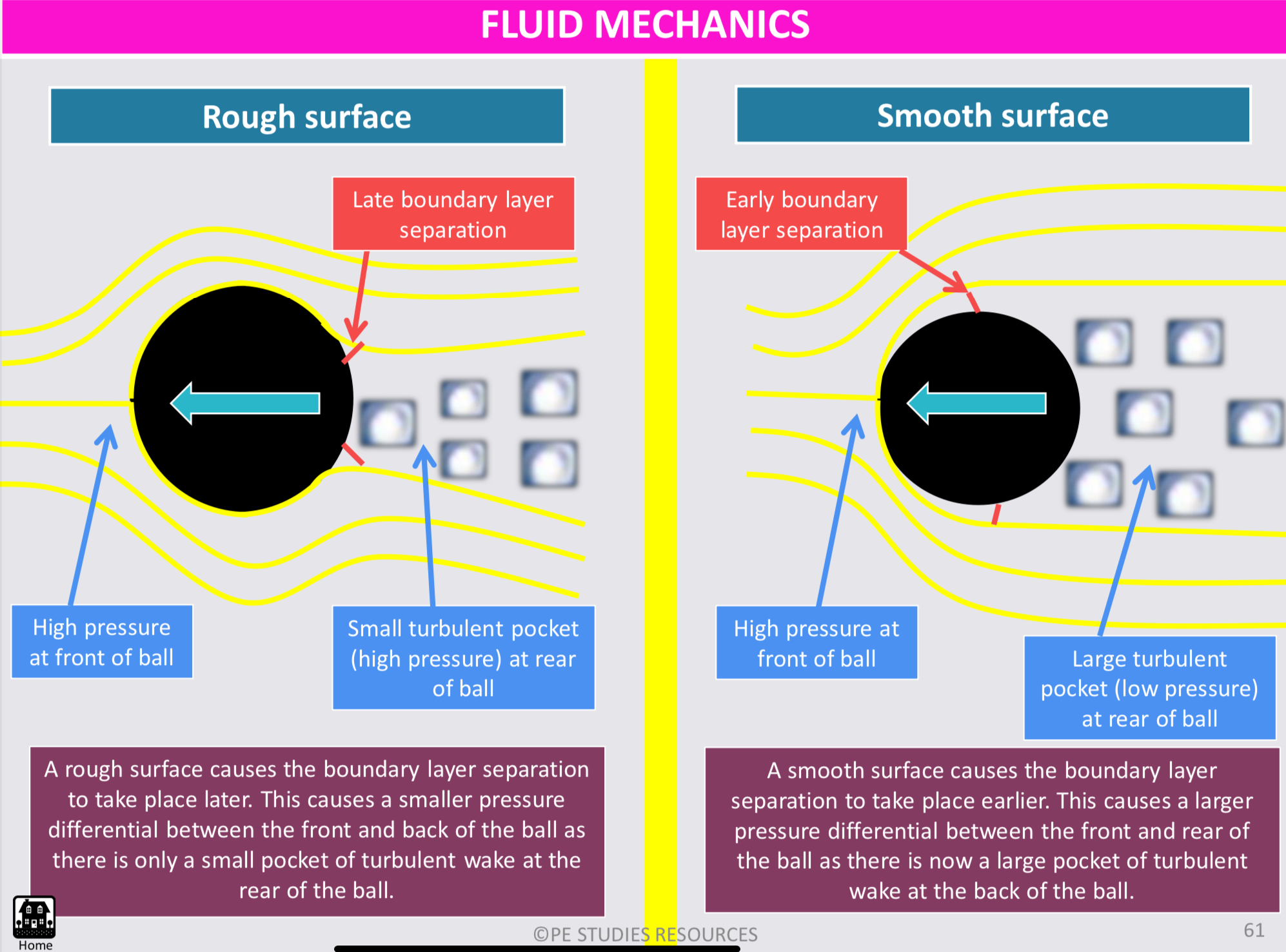
Velocity
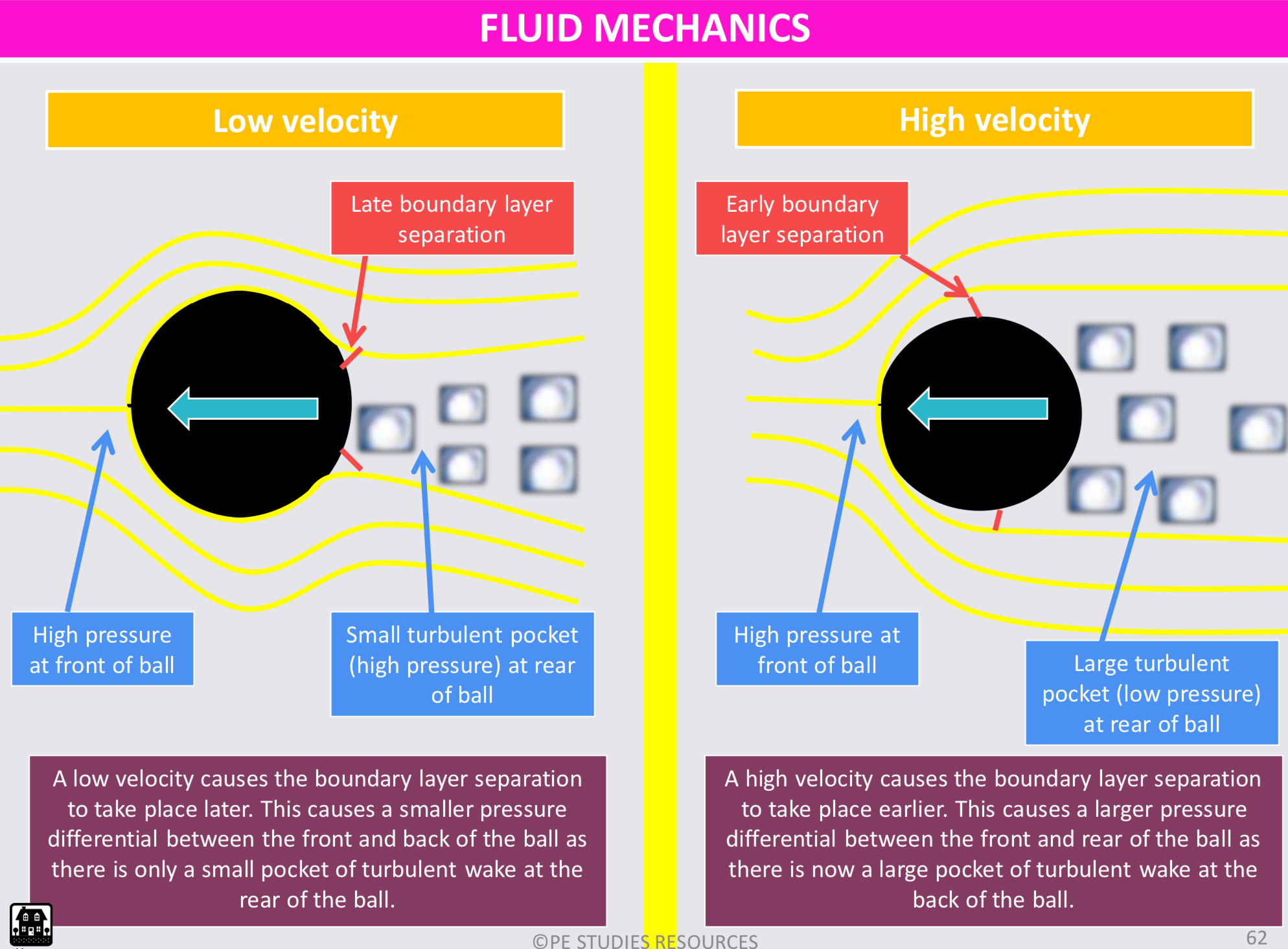
Shape
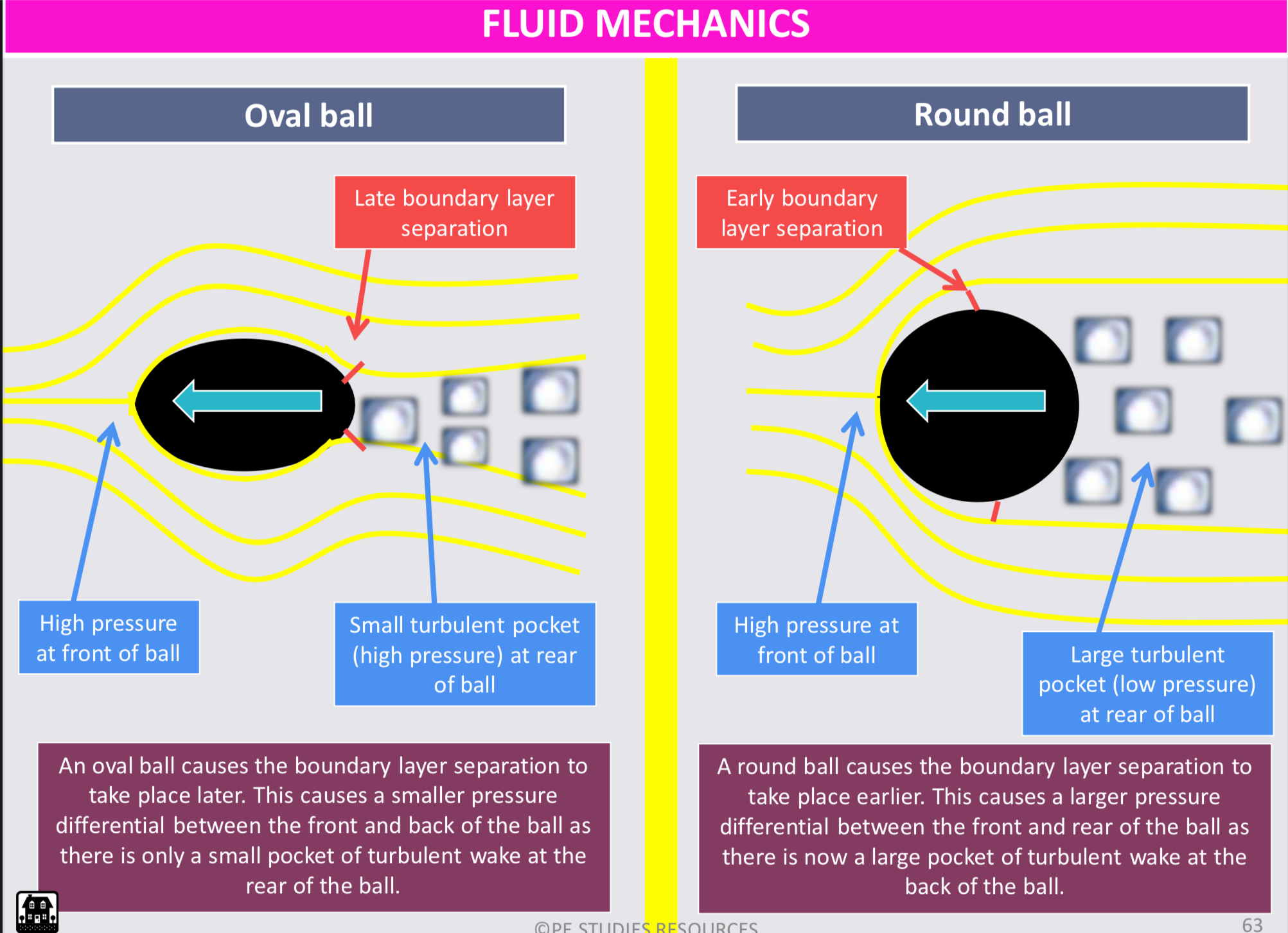
Surface drag (skin friction)
The friction produced between fluid and the surface of a moving object
relative velocity of moving object
Relative roughness of surface object
Viscosity of the fluid
Surface area of the object
Pressure drag (form drag)
The resistance created by the pressure differential between the front and back of an object moving through a fluid.
cross-sectional area (CSA) of the object presented to the fluid → e.g. cyclist crouched vs upright
Velocity of the object → higher speeds = more drag
Surface roughness → rough surface, air clings to surface for longer = later separation pt = less drag
Shape of object → round vs oval
Wave drag
The creation of waves forms resistance at the point where air and water interact OR when a body moves through the water, it causes waves to be generated, causing resistance to movement → swimmer
Relative velocity of the wave → greater velocity = greater wave drag
Technique → more streamlined in the water swimmers reduce the effects of wave drag. Swimming underwater further reduces wave drag. Overreaching in backstroke cause body to move through its own waves = resistance.
Open water (ocean) vs closed conditions (pool) → lane ropes reduce drag = displace moving surface water.
Drag summary
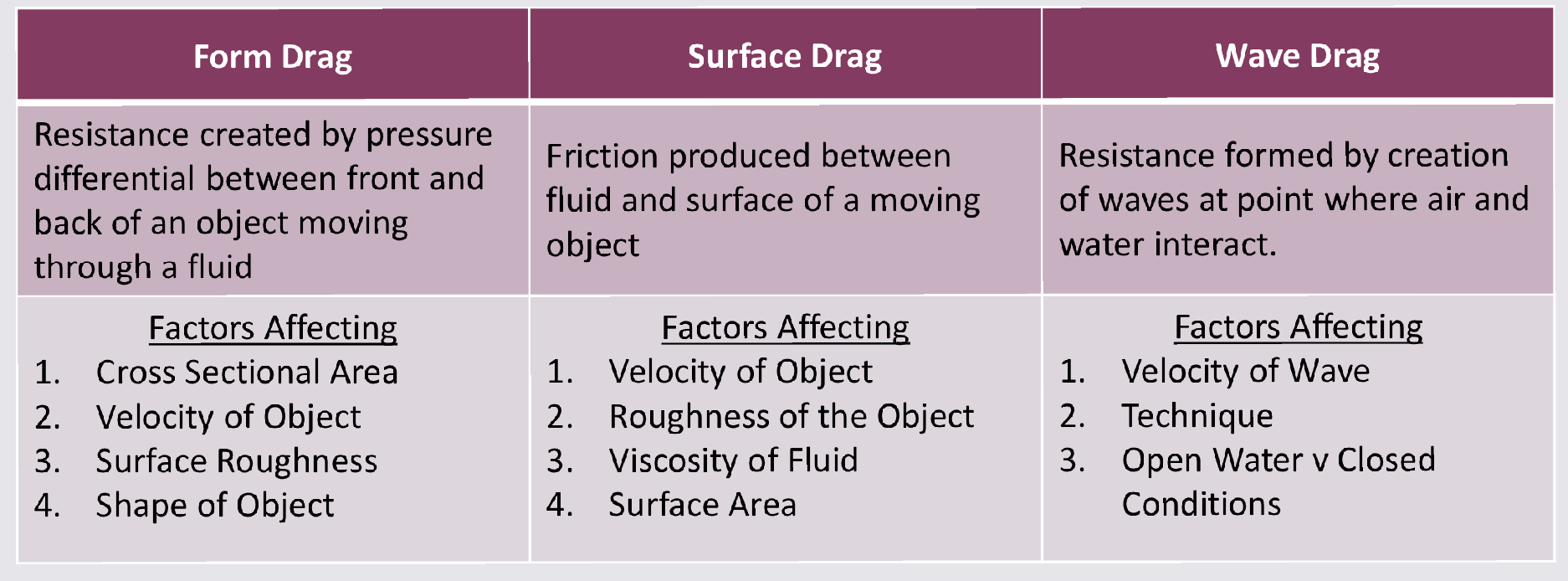
Factors affecting drag
Drag coefficient
measure used to quantify the drag or resistance of an object in a fluid environment
Directly related to cross-sectional area
Mass
greater mass of ball, less effect of drag
Velocity
faster ball moves through the air = earlier boundary layer separates from the ball = large pressure differential between front and rear of ball = more drag
Surface roughness
rougher surfaces = air streams cling to ball for longer periods = small pressure differential between front and back of ball = less drag
Cross sectional area (CSA)
linear relationship exists between CSA exposed to air and drag (increased CSA = increased drag)
Shape
round ball vs oval ball → oval passes through air more cleanly than round = encourages air stream to cling to contours of the ball =
LIFT & BERNOULLI’S PRINCIPLE
Lift
Refers to the. Component of force that acts perpendicular to the direction of flow
can act in upward and downward direction
Only occurs in objects that are spinning or not perfectly symmetrical
Lift is created by pressure differentials (high/low) on opposite sides of an object due to fluid flow past the object.
Bernoulli’s principle
Relates to the pressure created from a moving fluid over an object, whereby fast flowing fluid produces low-pressure area and slow-moving fluid produces a high-pressure area.
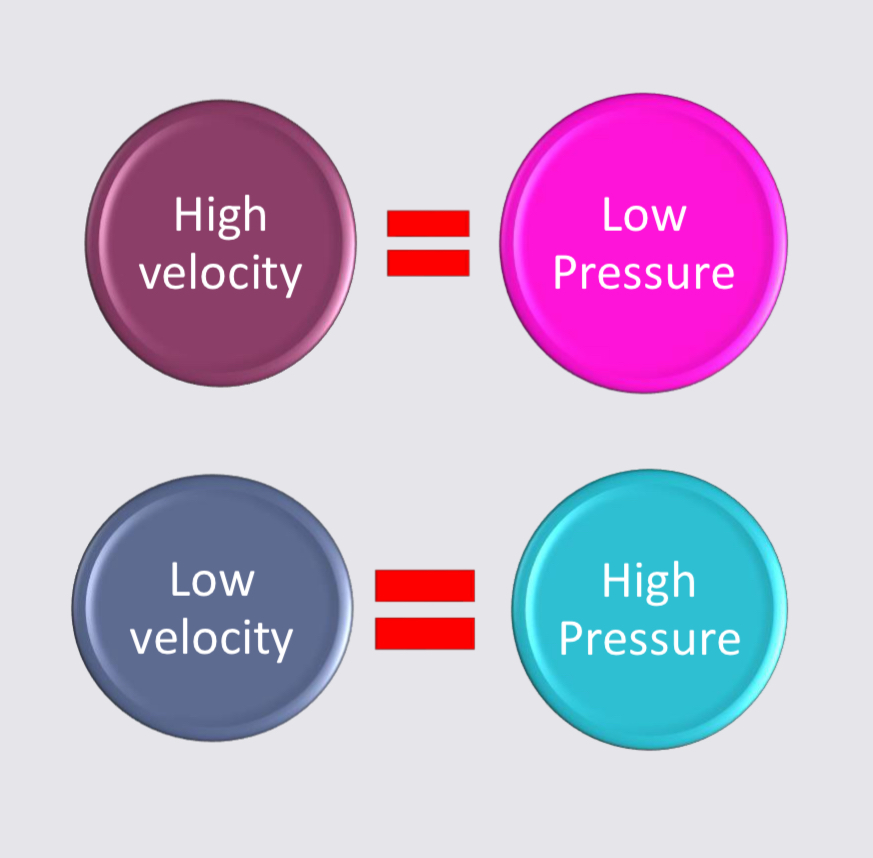
Diagram
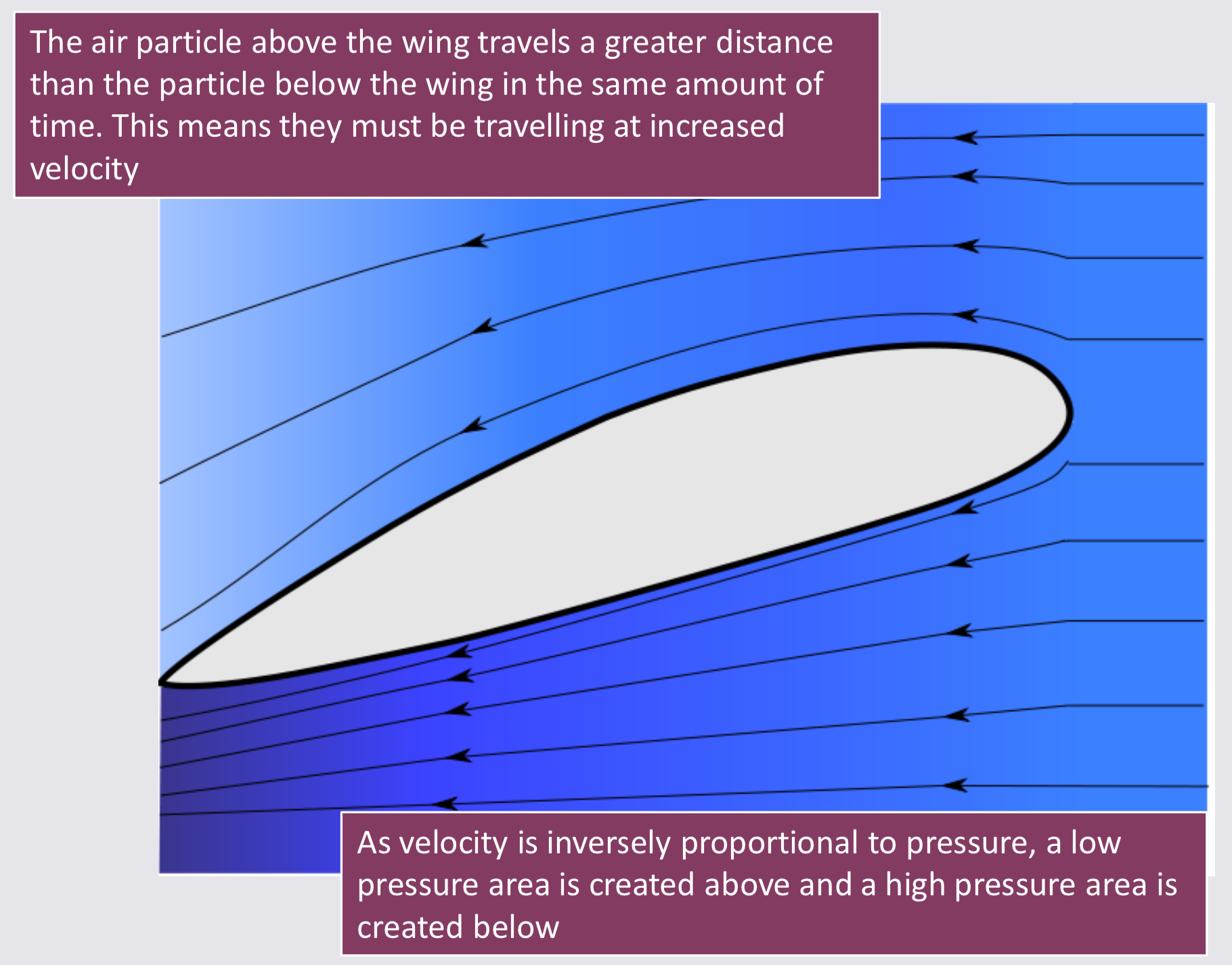
Diagram
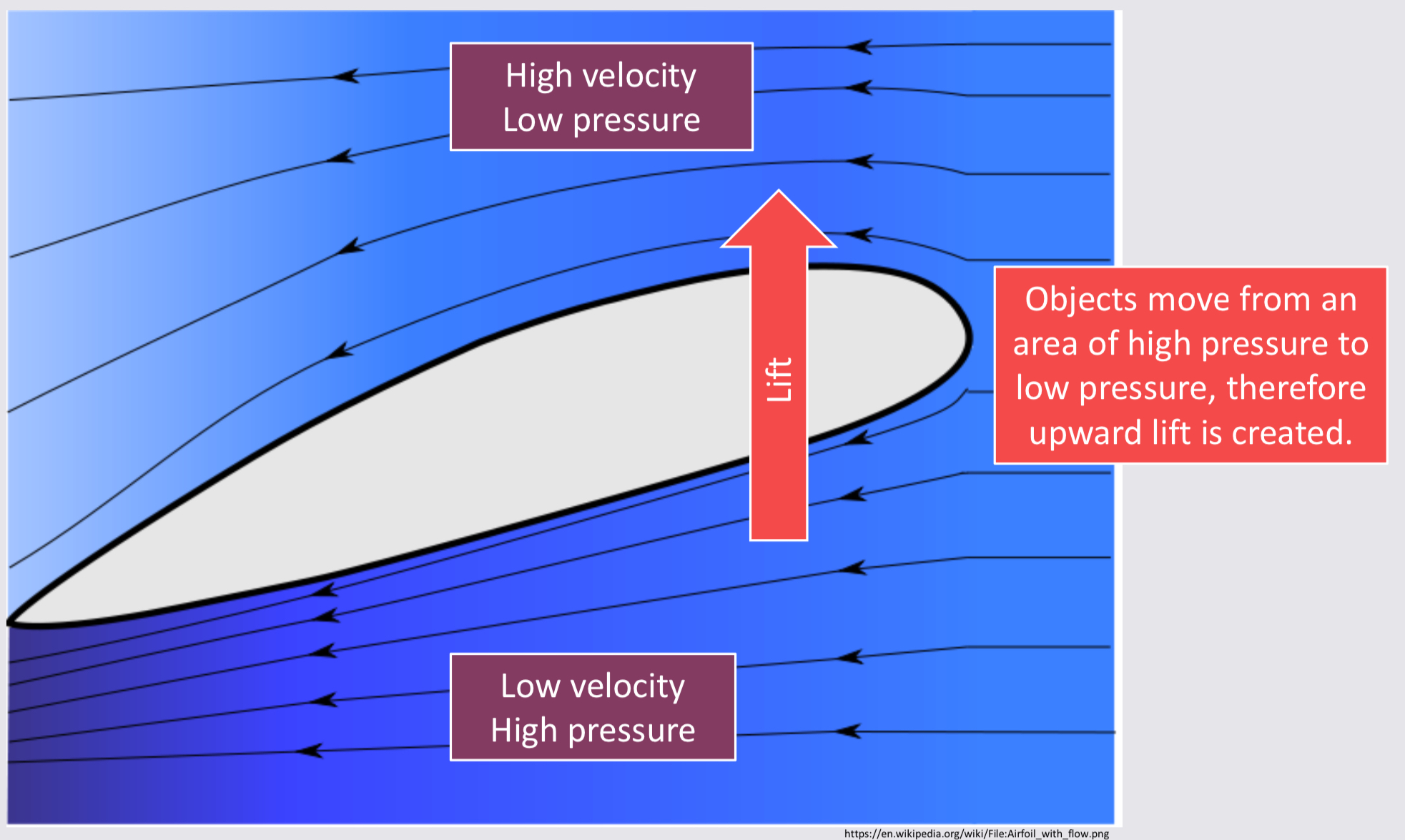
e.g.
Plane → high velocity above wing = low pressure and low velocity below wing = high pressure
Sailing
Race car → lift going down! Opposite to what we’ve spoken about. CAN WORK BOTH WAYS
MAGNUS EFFECT
Magnus effect
The term used to describe the effect of rotation on an object’s path as it moves through a fluid.
applies Bernoulli’s principle to explain effect spin has on trajectory / flight path of an object
When a ball is struck with an eccentric force (off centre), there is both linear and angular rotation. Rotating ball interacts with the oncoming air. Resultant movement (curve) is referred to as the Magnus effect.
Types of spin
Topspin
causes the ball to drop/dip and travel shorter in flight, which allows for a greater margin of error when hitting over a net.
Ball can be hit with more velocity, impacting the opponent’s time to return the shot
Backspin
causes the ball to rise higher in the air and travel further (max distance activities)
Used to keep ball in play if the player needs to stay in the rally/gives player time to get back into position
Side spin
causes the ball to curve to left/right depending what side the ball spin is imparted
Used to curve the ball away from opponent’s reach or around obstacle
Spin affects both flight path or ball and way it bounces after making contact with a surface.
Topspin diagram
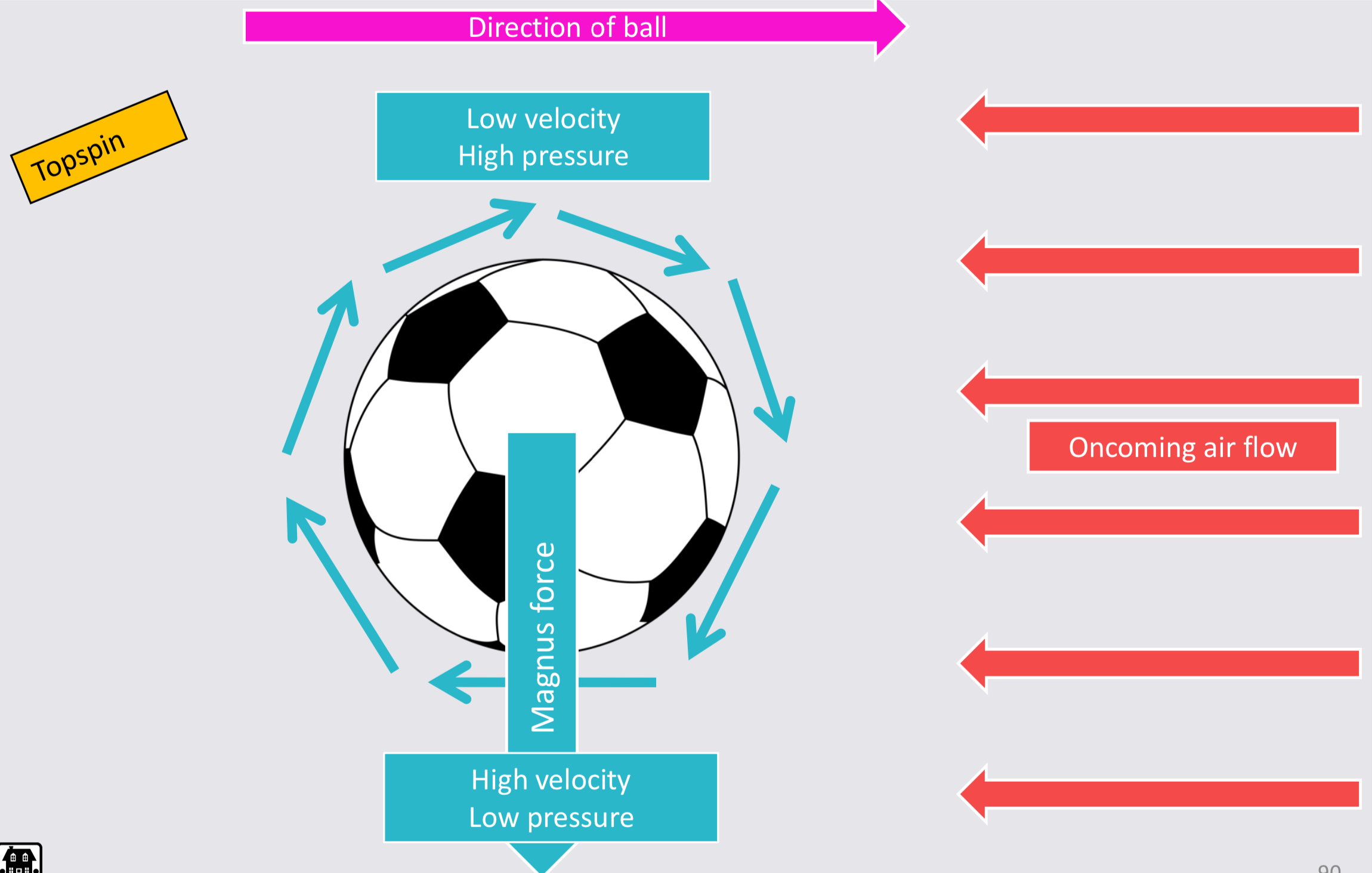
Backspin diagram
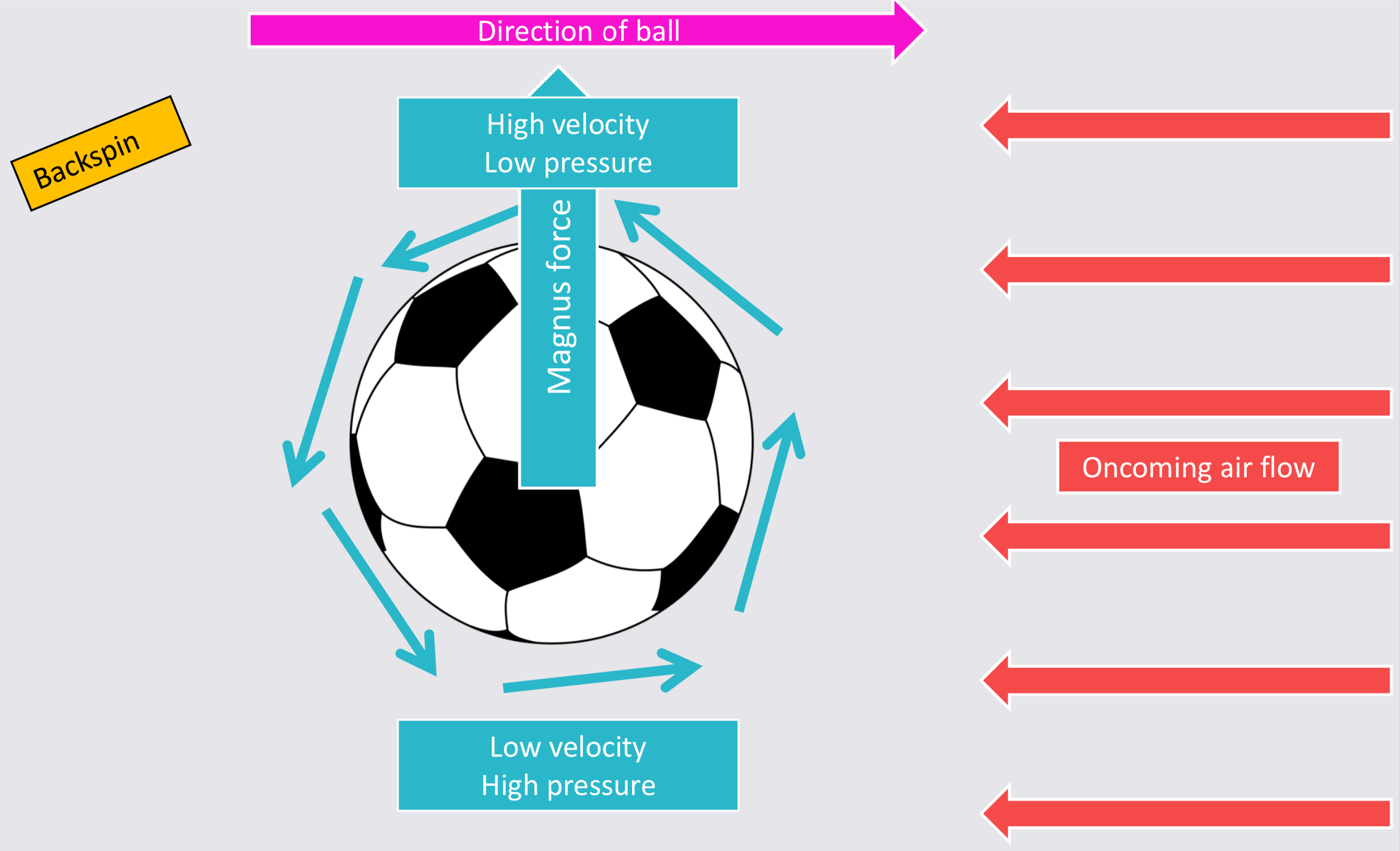
Sidespin diagram

Effect of spin on flight path of the ball
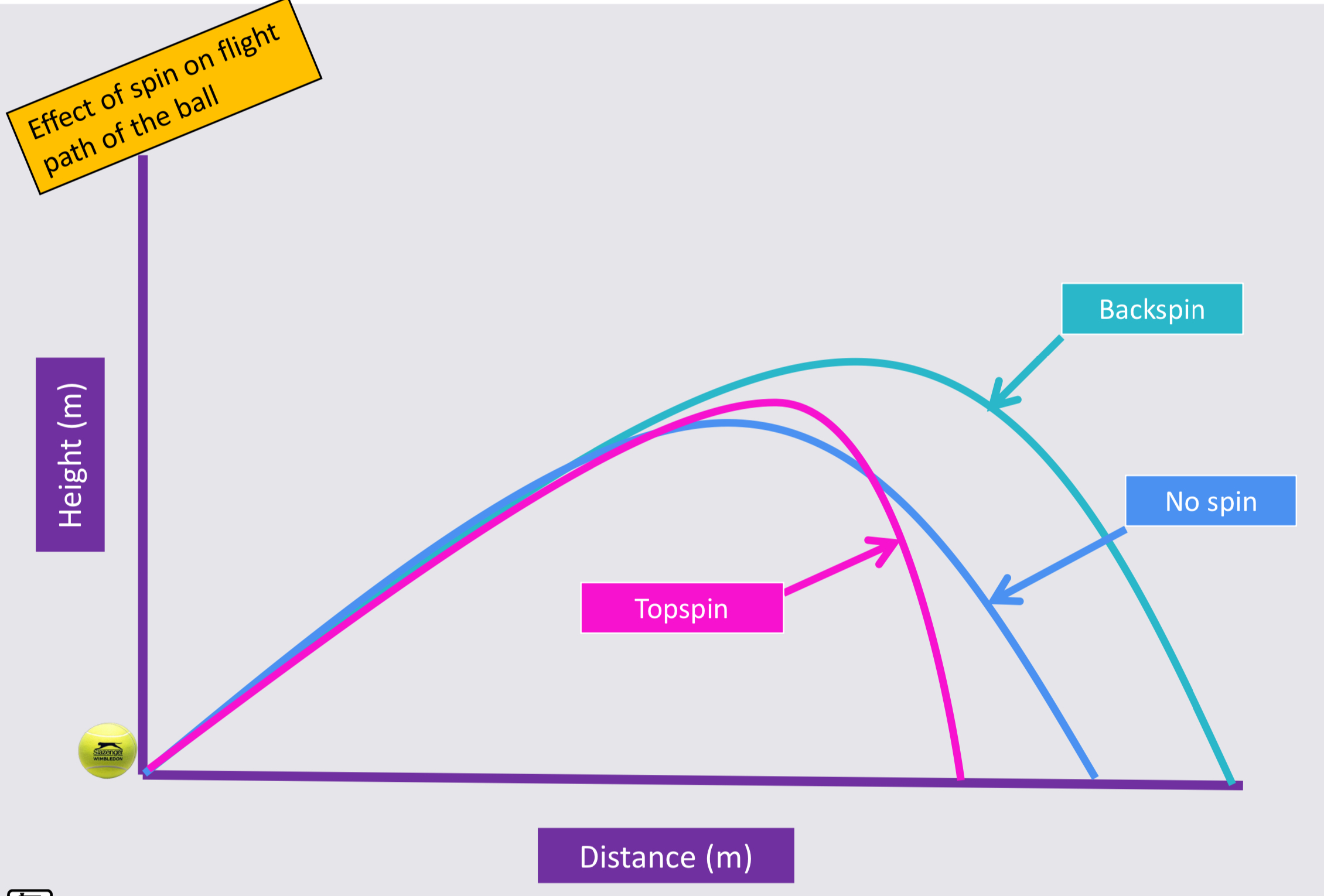
Effect of spin on the bounce of the ball
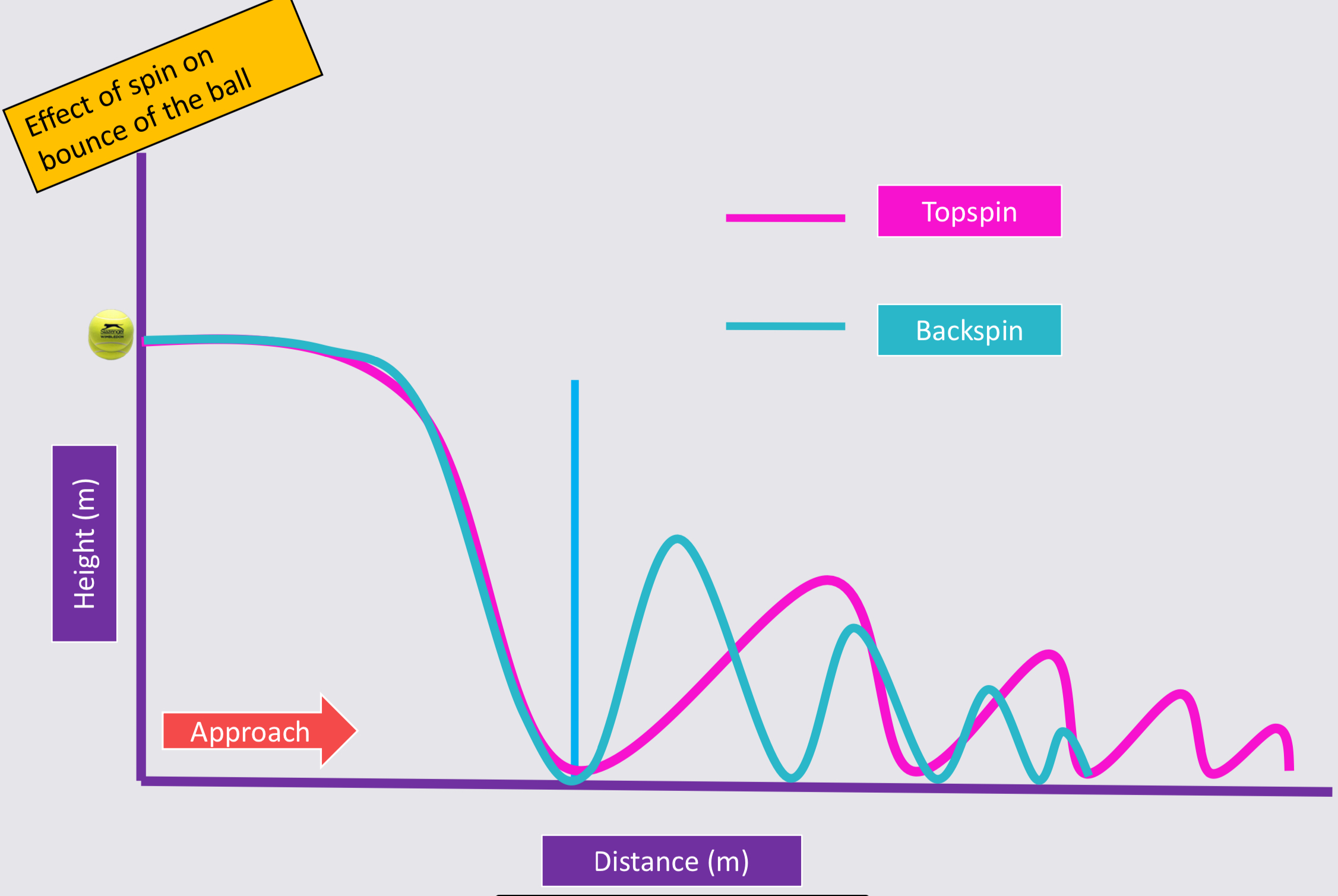
e.g.
Golf → sidespin, work ball around corners or backspin, ball approaches great from steeper angle
Soccer → backspin, greater distance and increased time or sidespin, shooting goal and passing